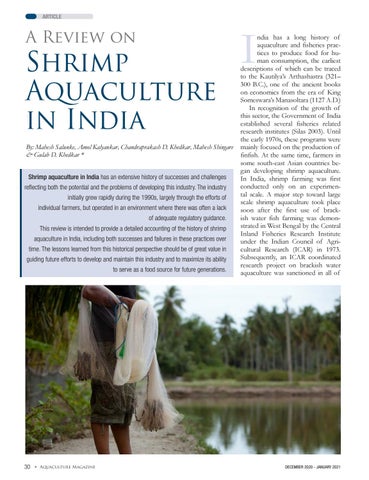ARTICLE
A Review on
Shrimp Aquaculture in India By: Mahesh Salunke, Amol Kalyankar, Chandraprakash D. Khedkar, Mahesh Shingare & Gulab D. Khedkar * Shrimp aquaculture in India has an extensive history of successes and challenges reflecting both the potential and the problems of developing this industry. The industry initially grew rapidly during the 1990s, largely through the efforts of individual farmers, but operated in an environment where there was often a lack of adequate regulatory guidance. This review is intended to provide a detailed accounting of the history of shrimp aquaculture in India, including both successes and failures in these practices over time. The lessons learned from this historical perspective should be of great value in guiding future efforts to develop and maintain this industry and to maximize its ability to serve as a food source for future generations.
30 »
I
ndia has a long history of aquaculture and fisheries practices to produce food for human consumption, the earliest descriptions of which can be traced to the Kautilya’s Arthashastra (321– 300 B.C.), one of the ancient books on economics from the era of King Someswara’s Manasoltara (1127 A.D.) In recognition of the growth of this sector, the Government of India established several fisheries related research institutes (Silas 2003). Until the early 1970s, these programs were mainly focused on the production of finfish. At the same time, farmers in some south-east Asian countries began developing shrimp aquaculture. In India, shrimp farming was first conducted only on an experimental scale. A major step toward large scale shrimp aquaculture took place soon after the first use of brackish water fish farming was demonstrated in West Bengal by the Central Inland Fisheries Research Institute under the Indian Council of Agricultural Research (ICAR) in 1973. Subsequently, an ICAR coordinated research project on brackish water aquaculture was sanctioned in all of
DECEMBER 2020 - JANUARY 2021
